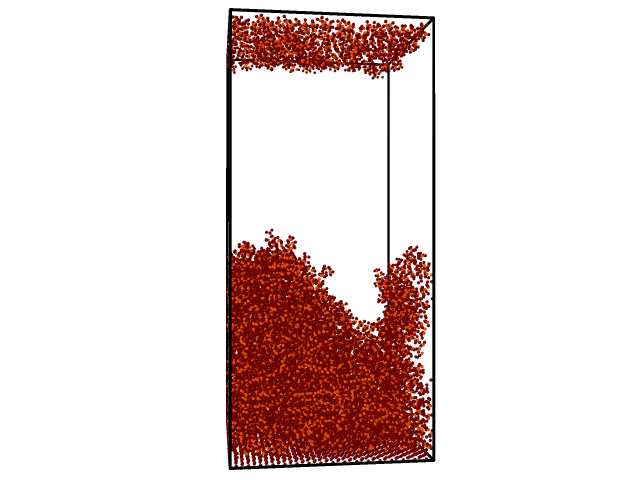Dear All,
I’m modeling a fluid on a substrate and trying to get it to its correct density on the substrate using the NPT ensemble. I’m applying the barostat just to the z-direction to keep the substrate intact. Unfortunately, the volume stops shrinking at some point after 2ps, and I’m left with a wrong density and enormous negative pressures. I would appreciate your input on the problem. The code, output, and image are as follows;
Input:
clear
units real
boundary p p p
atom_style full
read_data fluid.data
group fluid type 1:30 32:69
lattice fcc ---
region substrate block 0.0 61.625 0.0 61.625 0.0 3.625 units box
create_atoms 31 region substrate
group substrate type 31
# ==================================== Interactions =========================
bond_style harmonic
angle_style harmonic
dihedral_style harmonic
improper_style harmonic
pair_style hybrid lj/cut/coul/long 12.0 10.0
kspace_style pppm 0.0001
special_bonds lj 0.0 0.0 0.5 coul 0.0 0.0 1.0 angle yes dihedral yes
include "My_setting.input"
# ===========================================================================
neighbor 2.0 bin
neigh_modify every 1 delay 0 check no
reset_timestep 0
timestep 0.1
thermo 1000
thermo_style custom step temp etotal press vol density
velocity fluid create 300.0 4928459 rot yes dist gaussian
fix 1 all npt temp 300 300.0 1.0 z 1.0 1.0 1000.0 drag 1.0 dilate substrate
fix freeze substrate setforce 0.0 0.0 0.0
dump 1 all custom 10000 Trajectories/dump.pos.* id mol type q x y z vx vy vz
run 1000000
write_data Trajectories/data.NPTequilibration*
output:
| Step | Temp | TotEng | Press | Volume | Density |
|---|---|---|---|---|---|
| 0 | 276.88822 | 146025.02 | 44182.343 | 1139292.2 | 0.31560197 |
| 10000 | 299.88122 | -28540.013 | -533.47346 | 1098571.1 | 0.3273005 |
| 20000 | 299.26042 | -28799.956 | -729.75996 | 1052442.4 | 0.34164613 |
| 30000 | 300.40534 | -29392.287 | -509.83968 | 1009404.2 | 0.35621296 |
| 40000 | 301.06122 | -29949.315 | -364.91893 | 968431.91 | 0.37128357 |
| 50000 | 299.82676 | -30543.019 | -745.2195 | 927746.8 | 0.38756572 |
| 60000 | 300.84502 | -30828.993 | -719.37462 | 887383.9 | 0.40519426 |
| 70000 | 299.17647 | -31676.042 | -694.40367 | 848425.96 | 0.42379993 |
| 80000 | 300.05681 | -32579.691 | -800.94226 | 810019.63 | 0.443894 |
| 90000 | 300.84153 | -33046.346 | -811.81568 | 773491.34 | 0.46485699 |
| 100000 | 300.08891 | -33858.211 | -833.10227 | 738268.88 | 0.4870351 |
| 110000 | 300.98323 | -34795.409 | -791.73706 | 703303.46 | 0.51124853 |
| 120000 | 300.01058 | -35274.475 | -1044.2651 | 670032.65 | 0.53663484 |
| 130000 | 300.09914 | -36184.233 | -1344.0993 | 637688.12 | 0.56385378 |
| 140000 | 299.81756 | -36971.788 | -1298.8514 | 606641.95 | 0.59271018 |
| 150000 | 300.28012 | -37782.043 | -1276.5986 | 577068.92 | 0.62308477 |
| 160000 | 300.46901 | -38205.26 | -1340.7503 | 550242.96 | 0.65346199 |
| 170000 | 300.17108 | -38355.818 | -1544.6005 | 529375.93 | 0.67922027 |
| 180000 | 300.00045 | -38559.119 | -1445.429 | 517689.18 | 0.69455355 |
| 190000 | 299.66369 | -38358.241 | -1671.447 | 516771.75 | 0.6957866 |
| 200000 | 299.96648 | -38388.54 | -1626.7359 | 516583.59 | 0.69604004 |
| 210000 | 300.04314 | -38441.914 | -1023.9868 | 516317.46 | 0.69639879 |
| 220000 | 299.3715 | -38874.461 | -1210.1786 | 518287.48 | 0.69375177 |
| 230000 | 300.89808 | -38803.557 | -1083.6293 | 516885.71 | 0.69563319 |
| 240000 | 299.9742 | -39186.729 | -1421.647 | 517446.16 | 0.69487975 |
